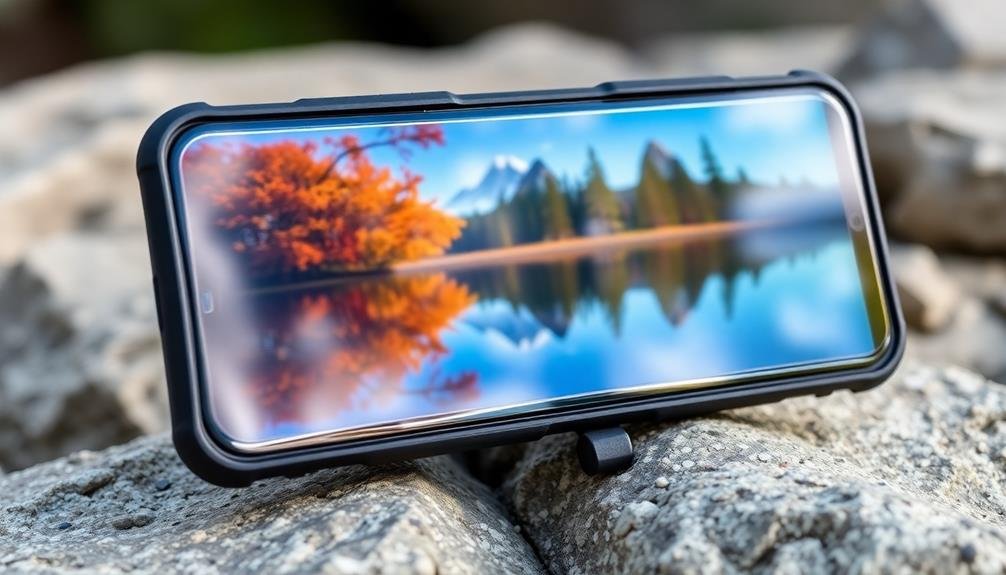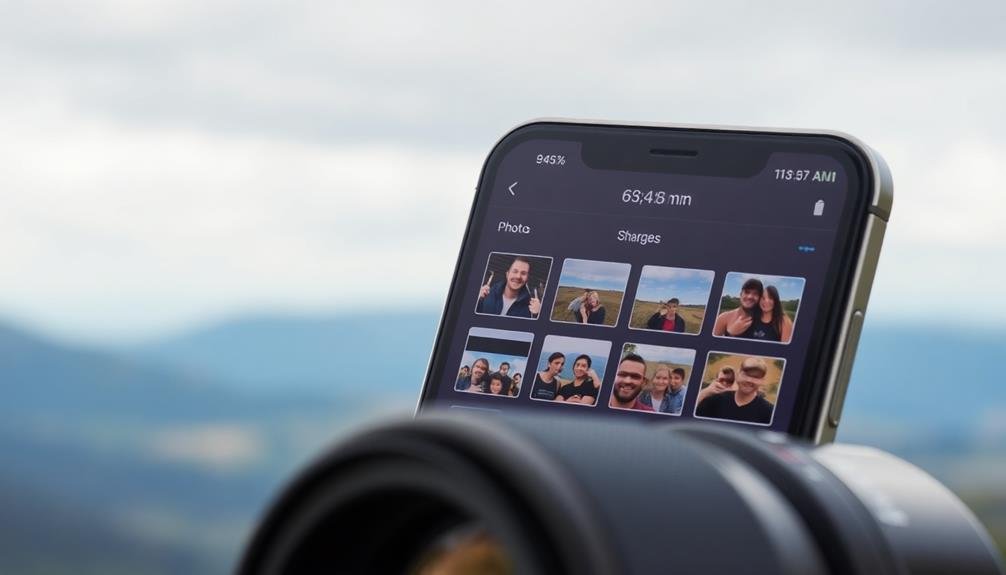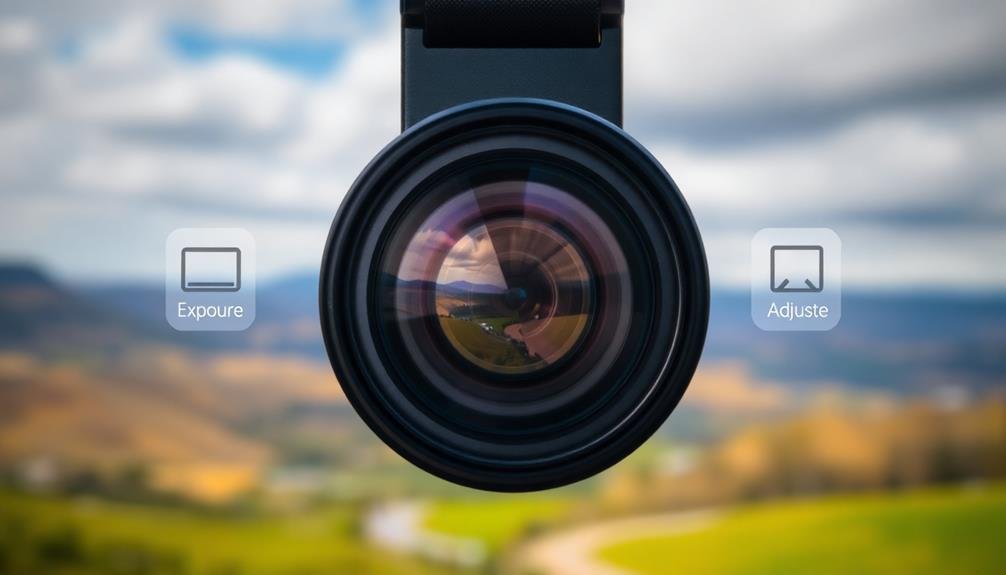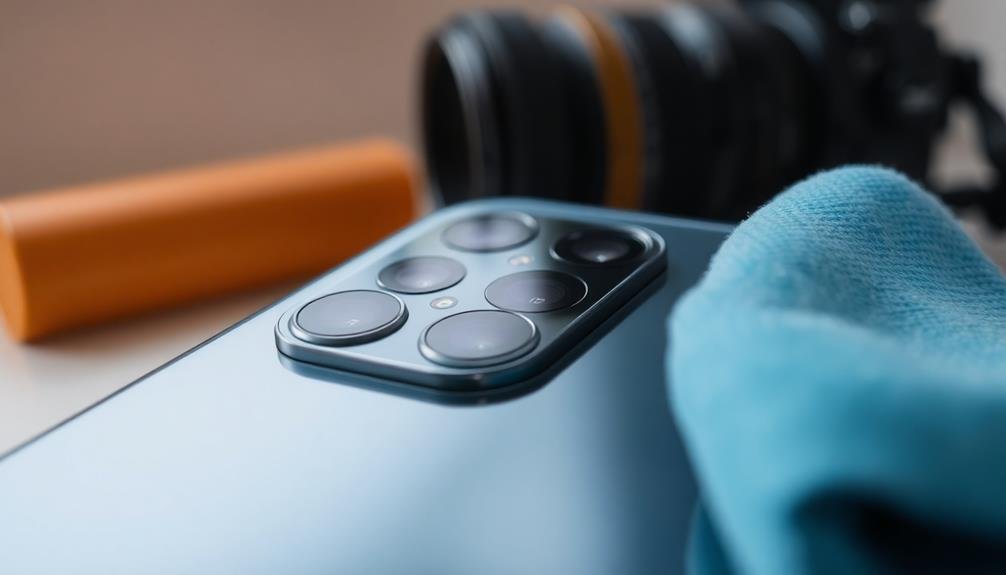To elevate your mobile photography game, prioritize camera care. Clean your lens regularly with a microfiber cloth to guarantee sharp, clear images. Protect your device with a quality case that offers dedicated lens protection. Avoid exposing your phone to extreme temperatures, which can damage components. Keep your camera software updated for peak performance and manage storage space wisely by backing up photos regularly. Handle your device with care to prevent drops and internal damage. By calibrating camera settings and using third-party apps, you'll access advanced features. These pro tips will help you capture stunning shots and make the most of your mobile camera's potential.
Clean Your Lens Regularly

To maintain ideal image quality, cleaning your camera lens regularly is essential. Your smartphone's camera lens is exposed to various elements throughout the day, accumulating dust, fingerprints, and smudges.
These contaminants can greatly impact your photos, causing blurry or hazy results.
Start by using a soft, lint-free microfiber cloth to gently wipe the lens surface. For stubborn smudges, slightly dampen the cloth with distilled water or lens cleaning solution.
Avoid using harsh chemicals or abrasive materials, as they can damage the lens coating.
Don't forget to clean the front-facing camera lens as well. It's often neglected but equally important for clear selfies and video calls.
Develop a habit of cleaning your lens before important photo opportunities. A quick wipe can make a noticeable difference in image quality.
If you're in dusty or sandy environments, consider using a small brush or air blower to remove particles before wiping. This prevents scratching the lens surface.
Protect With a Quality Case

When choosing a camera case, prioritize shock-absorbing materials to safeguard your equipment from accidental drops or bumps.
You'll want a case that offers ample padding, particularly around the corners and edges where impacts are most likely to occur.
Don't forget to guarantee the case provides dedicated protection for your camera's lens, as this delicate component is essential for capturing high-quality images.
Shock-Absorbing Materials Matter
Despite your best efforts, accidents happen. That's why it's essential to choose a case with effective shock-absorbing materials. Look for cases made with high-quality, impact-resistant materials like TPU (thermoplastic polyurethane), polycarbonate, or silicone. These materials excel at dissipating the force of impacts, protecting your camera from drops and bumps.
Consider cases with reinforced corners, as these areas are most vulnerable during falls. Some cases feature air pockets or specialized cushioning systems that provide additional protection.
Don't forget about the screen and lens areas – opt for cases with raised edges to prevent direct contact with surfaces when your phone is face-down.
Multi-layer cases often offer superior protection by combining hard outer shells with softer inner layers. This design absorbs shocks more effectively than single-layer options.
Keep in mind that while rugged cases provide excellent protection, they may add bulk to your device. Strike a balance between protection and usability that suits your needs.
Camera Lens Protection
How often do you consider the vulnerability of your camera's lens? It's one of the most critical components of your mobile device, yet it's constantly exposed to potential damage.
A quality case with built-in lens protection is vital for safeguarding this delicate part of your phone. Look for cases that feature a raised bezel around the camera module. This design elevates the lens above flat surfaces when you set your phone down, preventing direct contact and potential scratches.
Some cases even include a sliding cover or protective flap specifically for the camera area, offering an extra layer of defense against dust, debris, and impact.
Consider cases made with materials like TPU (thermoplastic polyurethane) or polycarbonate, which provide a good balance of protection and flexibility. These materials can absorb shock and resist scratches, keeping your lens safe from everyday hazards.
Don't forget about screen protectors that extend over the camera lenses. These specially designed protectors are optically clear and won't interfere with your photo quality while adding an extra barrier against damage.
Avoid Extreme Temperatures

Protecting your camera from extreme temperatures is essential for maintaining its performance and longevity. Extreme heat or cold can damage sensitive components, affect battery life, and compromise image quality. When shooting in hot conditions, keep your camera in the shade and use a light-colored camera bag to reflect heat. In cold weather, insulate your gear and bring extra batteries, as they drain faster in low temperatures.
Be mindful of rapid temperature changes, which can cause condensation inside your camera. When moving from cold to warm environments, seal your camera in a plastic bag to allow it to acclimate gradually. Here's a quick guide to temperature considerations:
| Temperature Range | Effects on Camera | Precautions |
|---|---|---|
| Below 32°F (0°C) | Battery drain, LCD issues | Use insulated bag, extra batteries |
| 32-104°F (0-40°C) | peak performance | Standard care |
| Above 104°F (40°C) | Sensor noise, overheating | Avoid direct sunlight, use shade |
Use Microfiber Cloths Only

Three key reasons underscore the importance of using only microfiber cloths to clean your camera.
First, microfiber's ultra-fine fibers effectively trap dust, dirt, and oils without scratching delicate lens surfaces or leaving residue. Unlike regular cloths or tissues, microfiber won't shed fibers that can accumulate on your lens or sensor.
Second, microfiber cloths are specially designed for optical cleaning. They're lint-free and non-abrasive, guaranteeing you won't accidentally damage your camera's sensitive components. This makes them ideal for cleaning not just lenses, but also LCD screens and camera bodies.
Lastly, microfiber cloths are reusable and easy to maintain. You can wash them regularly to remove accumulated dirt, making them a cost-effective and environmentally friendly option for long-term camera care.
When using microfiber cloths, remember to start from the center of the lens and work your way outward in a circular motion. Don't apply excessive pressure; let the cloth's properties do the work.
Always keep your microfiber cloths clean and store them in a dust-free container to prevent contamination. By using only microfiber cloths, you'll guarantee your camera stays in top condition, ready for your next perfect shot.
Update Camera Software

To keep your camera functioning at peak performance, you'll need to regularly update its software.
Access your camera's system updates through its menu or by connecting it to a computer.
Enable automatic updates if available, and don't forget to install manufacturer-recommended third-party apps that can enhance your camera's capabilities.
Access System Updates
While many photographers focus on cleaning their camera's exterior, keeping its internal software up-to-date is equally vital.
To access system updates for your mobile device's camera, start by opening your phone's settings menu. Look for the "Software Update" or "System Update" option, which is usually found near the top of the settings list.
Once you've located this section, tap on it to check for available updates. Your device will scan for the latest software versions and inform you if any are available. If an update is found, you'll see details about its size and the improvements it offers.
It's important to read through these notes, as they often include camera-specific enhancements.
Before initiating the update, verify your device is connected to a stable Wi-Fi network and has sufficient battery life or is plugged in. The update process can take several minutes, during which your phone may restart multiple times.
After the update is complete, open your camera app to verify that it's functioning correctly and to explore any new features or improvements.
Enable Automatic Updates
Automatic updates can be a time-saver for busy photographers who want to keep their camera software current. To enable this feature on your smartphone, navigate to your device's settings and locate the software update section. Look for an option to turn on automatic updates for your camera app or system software.
Once activated, your phone will download and install camera updates in the background, usually when you're connected to Wi-Fi and your device is charging. This guarantees you're always using the latest version with bug fixes, performance improvements, and new features.
Keep in mind that automatic updates may consume data and battery life. If you're concerned about these factors, you can set your phone to only download updates when connected to Wi-Fi.
You'll also want to verify you have enough storage space available for new updates.
While automatic updates are convenient, it's still a good idea to check for updates manually occasionally. Some critical updates may require your approval before installation.
Install Third-Party Apps
Innovation in smartphone photography isn't limited to built-in camera apps. Third-party camera apps can greatly enhance your mobile photography experience, offering advanced features and greater control over your shots. To elevate your skills, consider installing apps like ProCamera, Halide, or VSCO.
These apps often provide manual controls for exposure, focus, and white balance, allowing you to fine-tune your images. They may also offer RAW shooting capabilities, giving you more flexibility in post-processing.
Look for apps with specialized modes like long exposure, time-lapse, or astrophotography to expand your creative options.
When choosing third-party camera apps, read reviews and compare features to find the best fit for your needs. Some apps focus on specific photography styles, such as portrait or landscape, while others offer an extensive suite of tools.
Don't forget to explore editing apps like Snapseed or Lightroom Mobile to complement your shooting apps.
After installing new apps, take time to familiarize yourself with their interfaces and features. Experiment with different settings and techniques to make the most of your expanded toolkit.
Manage Storage Space Wisely

Efficient storage management is essential for professional photographers. When it comes to your smartphone, you'll need to be strategic about how you use your device's storage capacity.
Start by regularly backing up your photos to cloud services or external hard drives. This allows you to free up space on your phone without losing your precious images.
Enable your camera app's HDR mode selectively, as these files take up more space. Consider shooting in JPEG format instead of RAW for less critical shots, as RAW files are considerably larger.
Delete duplicate or poor-quality images promptly to avoid cluttering your storage.
Utilize your phone's built-in storage management tools to identify and remove unnecessary files, apps, and cached data.
Consider investing in a phone with expandable storage or opting for a model with higher internal storage capacity.
Handle With Care

Your smartphone's camera is a delicate piece of technology that deserves careful handling. Treat it with respect to guarantee peak performance and longevity. Always use a protective case that covers the camera lens when not in use. This shields it from scratches, dust, and accidental impacts.
When cleaning your camera lens, use a microfiber cloth specifically designed for optics. Avoid using harsh chemicals or abrasive materials that could damage the lens coating. If you're in a dusty environment, gently blow off particles before wiping to prevent scratching.
Here's a quick guide to handling your smartphone camera:
| Do's | Don'ts | Why |
|---|---|---|
| Use a lens cover | Touch the lens | Prevents smudges |
| Clean gently | Use shirt to wipe | Avoids scratches |
| Hold securely | Drop or bump | Protects internals |
Be mindful of extreme temperatures, as they can affect your camera's performance and battery life. In cold weather, keep your phone close to your body for warmth. In hot conditions, avoid leaving it in direct sunlight or in a hot car. By handling your smartphone camera with care, you'll maintain its quality and capture stunning photos for years to come.
Backup Your Photos

Taking care of your camera hardware is only half the battle. Safeguarding your precious photos is equally vital. Don't risk losing your cherished memories due to device failure or theft. Implement a robust backup strategy to protect your mobile photography.
Start by enabling automatic cloud backup on your smartphone. Services like Google Photos, iCloud, or Dropbox can seamlessly sync your images to secure online storage. Set up Wi-Fi-only backups to conserve data and guarantee your photos are regularly uploaded.
For added security, create local backups on your computer or external hard drive. Connect your phone and manually transfer photos periodically. Consider using backup software to automate this process and keep your local archives current.
Don't forget about your editing work. If you use mobile apps to enhance your photos, save both the original and edited versions. Some cloud services offer version history, allowing you to revert changes if needed.
Lastly, organize your backups effectively. Use folders or tags to categorize your photos by date, location, or event. This will make it easier to locate specific images when you need them, especially if you're managing a large collection of mobile photography.
Calibrate Camera Settings

A well-calibrated camera guarantees ideal image quality and consistency in your mobile photography. To optimize your device's performance, you'll need to adjust various settings regularly. Start by checking your camera's white balance to verify accurate color reproduction across different lighting conditions. Next, fine-tune your exposure settings to capture the perfect amount of light for each shot.
Don't forget to calibrate your focus settings, verifying crisp and sharp images every time. Pay attention to your camera's ISO settings, adjusting them based on the available light to minimize noise in your photos. Here's a quick reference guide for calibrating your camera settings:
| Setting | Purpose | Low Light | Bright Light |
|---|---|---|---|
| White Balance | Color accuracy | Warm (3000K) | Cool (5500K) |
| Exposure | Light control | Longer shutter | Shorter shutter |
| Focus | Image sharpness | Manual focus | Auto focus |
| ISO | Light sensitivity | Higher (800+) | Lower (100-400) |
Remember to recalibrate your settings whenever you encounter significant changes in lighting conditions or subject matter. By consistently fine-tuning your camera's parameters, you'll verify that your mobile photography always looks its best, regardless of the shooting environment.
Frequently Asked Questions
How Often Should I Replace My Smartphone's Camera Lens?
You don't typically need to replace your smartphone's camera lens. It's built to last the life of your device. However, if you notice scratches or damage affecting image quality, consider professional repair or upgrading your phone.
Can Using Third-Party Camera Apps Damage My Phone's Camera Hardware?
No, using third-party camera apps won't damage your phone's camera hardware. They're just software that accesses your camera's existing capabilities. However, some apps might drain your battery faster or collect data, so choose reputable ones.
Is It Safe to Use Lens Attachments on My Smartphone Camera?
Using lens attachments on your smartphone camera is generally safe. However, you'll want to choose high-quality, well-fitting attachments to avoid scratches or damage. Be careful when attaching and removing them, and keep your phone's lens clean.
How Can I Prevent Lens Fog When Taking Photos in Humid Conditions?
To prevent lens fog in humid conditions, you'll want to acclimate your camera slowly. Keep it in a sealed bag when moving between temperatures. Use anti-fog wipes or a dehumidifier, and don't breathe directly on the lens.
What's the Best Way to Clean My Phone's Camera Sensor?
You shouldn't clean your phone's camera sensor yourself. It's best to leave this to professionals. Instead, focus on keeping the lens clean with a microfiber cloth. If you suspect sensor issues, take it to a repair shop.
In Summary
You've now got the essential tips to keep your smartphone camera in top shape. Remember, it's not just about taking photos—it's about caring for your gear. By following these simple steps, you'll guarantee your mobile camera stays clean, protected, and ready to capture life's moments. Don't forget to back up your memories and keep your software updated. With proper care, you'll elevate your mobile photography game and snap stunning shots for years to come.





Leave a Reply